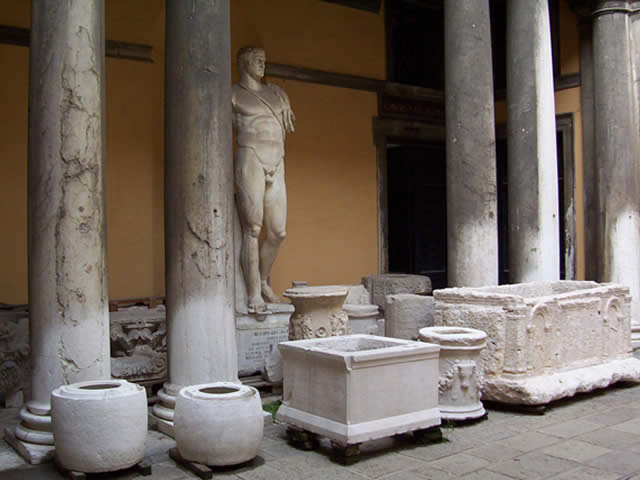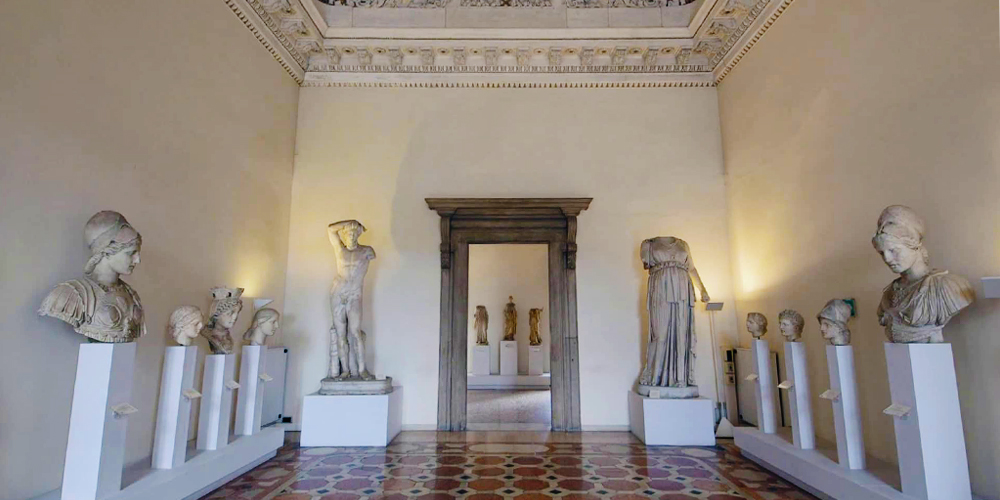Archaeology isn't what you find, it's what you discover.David Hurst Thomas
Did you know that there is a beautiful museum in Venice, home to a majestic collection of ancient sculptures, including some Greek originals of the finest workmanship, and then bronzes, ceramics, but also gems and coins, as well as the archaeological collection in storage by the Civico Museo Correr, with works ranging from ancient Egypt to the Assyrian-Babylonian Middle East. This is the National Archaeological Museum of Venice.
Let's discover it together!
The origins of the museum

Its historical nucleus of the National Archaeological Museum of Venice is composed of the so-called "Public Statuary of the Serenissima" made in 1596 in the setting curated by Federico Contarini, in the room before the entrance of the Libreria Marciana. This consists of the collections of ancient objects derived from the legacy of Cardinal Domenico Grimani, a great man of humanistic culture, together with the donation of his nephew Giovanni Grimani, Patriarch of the Catholic Church, who gave life to what is known as the "Grimani Collection". The library itself, of 15th century origin, contains several works and manuscripts from the ancient world, proof of the attention and care that the Venetians dedicated to archaeological research.
With the passing of time and centuries, this Statuary was embellished with further donations to the point that it even needed to be transferred to the Ducal Palace. From here the entire collection was kept in Florence during the First World War. It was in the 1920s that the collections returned to Venice and were placed on the first floor of the Procuratie Nuove, which still houses the Museum, with the rooms enlarged and the collections increased between 1949 and 1954 thanks to the Correr deposit and the assignment to the city of Venice of ceramics, glass and gems from the Museum of San Donato in Zadar (today Zadar, Croatia): now the museum itinerary winds its way through 20 rooms thanks to the layout curated by Professor Carlo Anti.
What not to miss in the National Archaeological Museum of Venice

The museum itinerary is divided into 20 exhibition rooms that lead visitors to that first nucleus of ancient statues, the so-called "public statuary", now presented following the original scheme, so that they can dive into ancient museological models as well as works.
In the first rooms are preserved Roman finds, burial stelae and public inscriptions, mostly from the island of Crete. A little further on, part of the museum's rich numismatic collection (5th century BC - 17th century) is on display: Greek, Roman-Republican and imperial coins, coins minted in the provinces, examples of barbarian coinage and a collection of Byzantine coins from the 5th to the 13th century. This brings us to an incredible environment, which contains original examples of Greek sculptures, many of which still retain traces of Renaissance restorations. The figures cannot be identified with certainty: it is presumed that they may be votive statues from an island sanctuary.
Great space is also given to portraiture statuary from the Hellenistic period (III-II century B.C.) which presents the main characteristics of Greek portraiture, such as attention to symmetry and proportions based on geometric principles or designed according to the new optical and movement principles. Worth mentioning: the Ara Grimani, an original of Hellenistic art perhaps from Rome. Worth mentioning in the Hellenistic rooms: the group of Venetian Galatians, part of the collection that Domenico Grimani had formed with works coming mostly from his own land in Rome.
There is an imposing space for the rooms dedicated to funerary sarcophagi, some of which are very important with particular figurative decorations in relief on three sides. In these rooms it is important to note: the "capsella di Samagher", a reliquary in ivory and silver decorated with Christian subjects, dating back to the 5th century AD.
Thus begins an itinerary called "From the Nile to the Archaeological Museum" - a precise and exhaustive thematization to follow the finds concerning Egypt through the last rooms, a sort of connection between the Greek-Roman finds with strong Egyptian influences and the following Egyptian-Eastern section, which preserves several examples of amulets and furnishings. This brings us to the anti-sala of the Marciana Library, the very first seat of the Public Statuary of the Serenissima, where the original layout of the museum is reproduced on the basis of drawings by Anton Maria Zanetti the Younger.
Useful information
The Archaeological Museum is part of the integrated museum itinerary called "The Museums of St. Mark's Square": the entrance coincides therefore with that of the Civic Museum Correr, in St. Mark's Square, Napoleon's wing.
The integrated single ticket "The Museums of St. Mark's Square", includes a visit to the Doge's Palace, the Correr Museum, the Archaeological Museum and the Monumental Rooms of the Marciana Library can be purchased during Correr's opening hours, at the Correr ticket office or at the ticket office of the Doge's Palace, and it has a cost of € 25 (full price) and € 13 (reduced price).
The Museum is open every day from 10.30 to 18.00.
Following the provisions of the Prime Minister's Decree for Covid-19 containment measures, we inform you that:
- before the entrance (from the Correr Museum) the temperature will be checked ;
- it will be necessary to sanitize the hands and wear the mask throughout the visit;
- the visit path is mandatory one-way;
- a maximum of 4 visitors can stay in each room, keeping the distance of at least 1 meter from each other;
- to avoid gatherings, the Egyptian rooms will be open to visitors only on request, 2 people at a time;
- accompanied groups are allowed in compliance with the maximum capacity of each room and the spacing rules.










Lascia un commento